Fiddle leaf figs (Ficus lyrata) are some of the most popular houseplants around and are commonly found at plant nurseries and garden centers. Prized for their distinctive, fiddle-shaped leaves, these small indoor trees make fine accent plants in homes and houseplant collections. However, these plants can often develop unsightly brown spots on their leaves, which can detract from their look or even compromise the plant’s health.
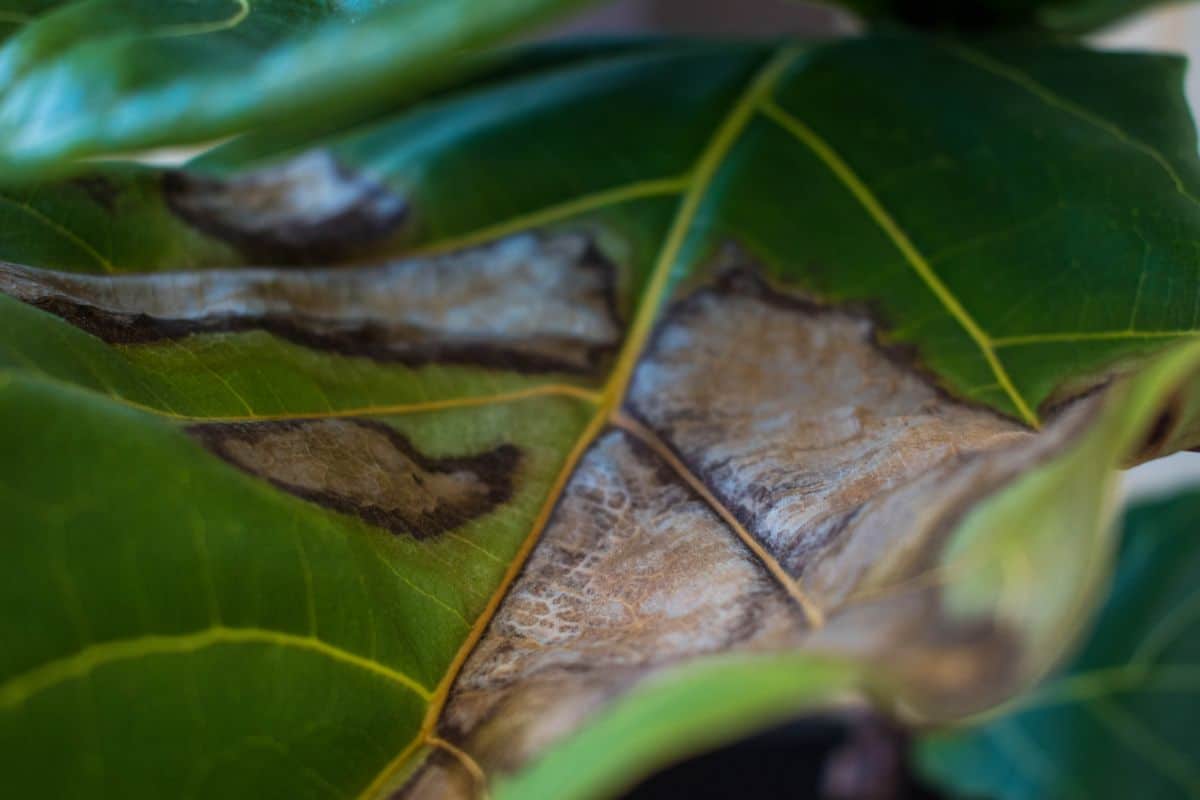
If you have a fiddle leaf fig that isn’t looking its best, this article is for you. Brown spots on fig leaves can be quite common, but they also can be easily fixable if you understand your plant’s needs and how to identify the issues your plant is facing. Below, we’ll walk you through the most likely reasons fiddle leaf figs may develop brown spots and what to do about it.
Jump to:
5 common causes of brown spots on fiddle leaf fig leaves
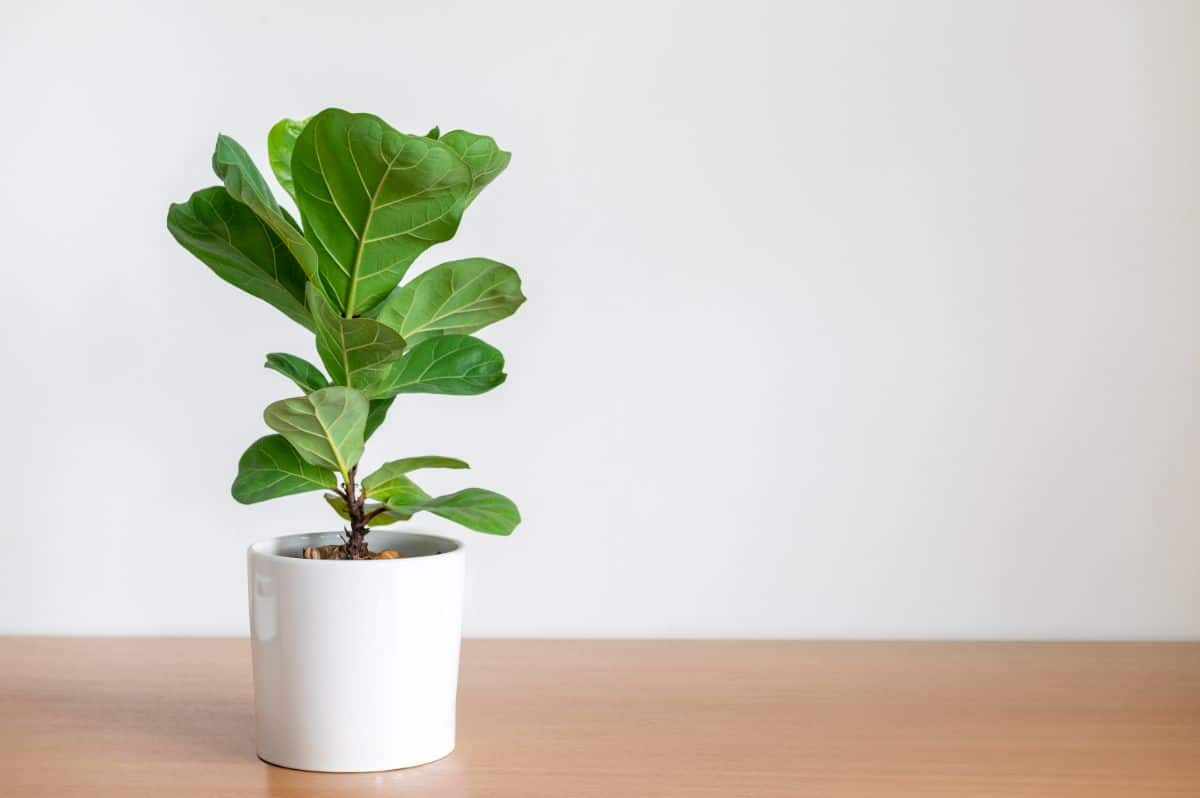
Brown spots on fiddle leaf fig leaves aren’t unusual, but they do signify that your plant needs some help. Luckily, with a bit of know-how, these spots are usually fixable, and your plant should bounce back just fine. While there are over a dozen possible causes for brown spotting on fiddle leaf fig leaves, here are the top 5 most common culprits and how to fix them.
1. Root rot and overwatering
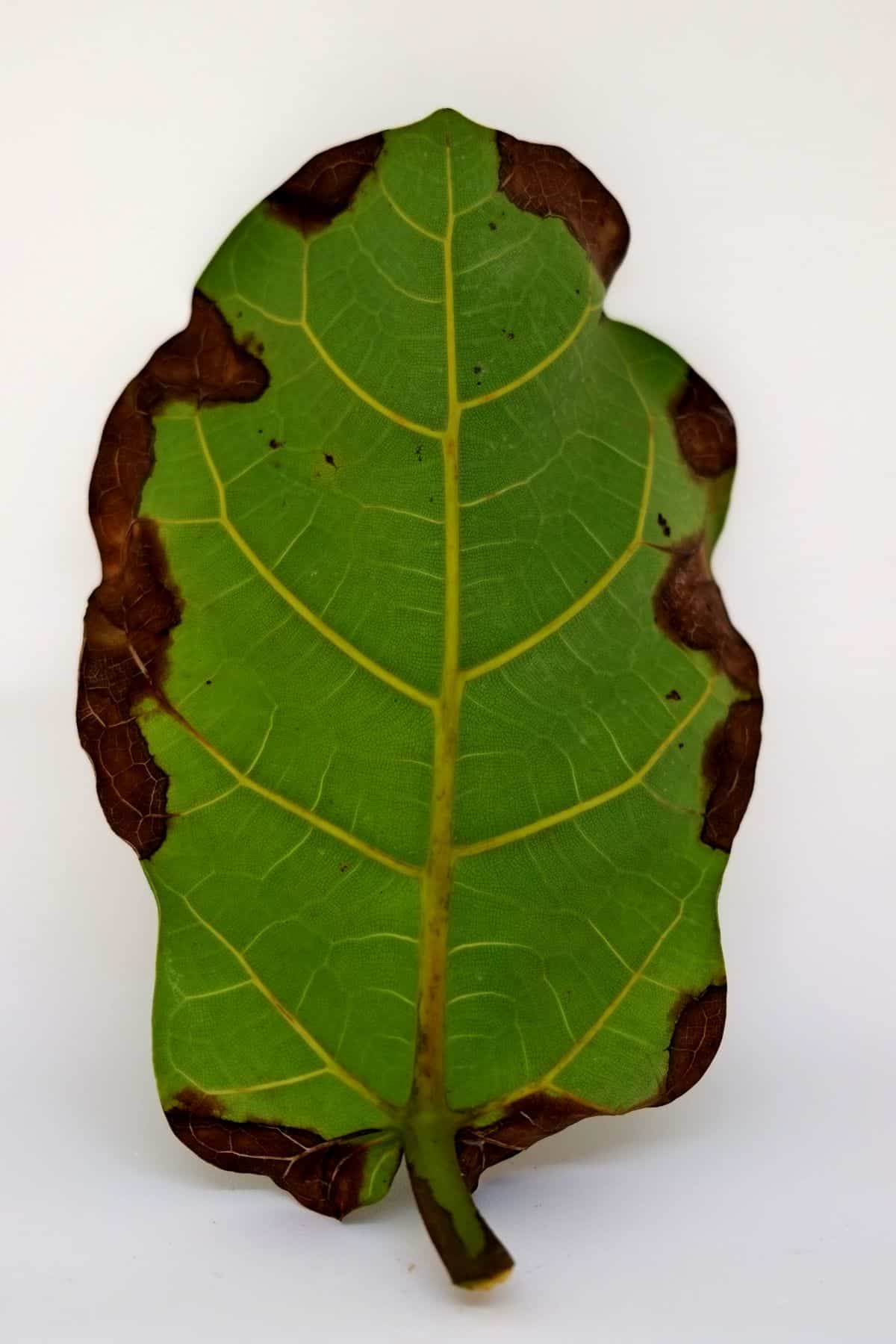
Overwatering and root rot is the most frequent cause of brown spots on fiddle leaf figs by a large margin. While fiddle leaf figs are tropical plants, they need fast-draining soil, and they don’t like to sit in soggy earth.
Overwatered soil can reduce airflow around your plant’s delicate roots and essentially drown your plant. These conditions can also be a breeding ground for fungus and bacteria that develop into root rot. If root rot isn’t treated quickly, brown spotted leaves can spread throughout your plant, and your fig tree will die.
To determine if you’re dealing with an overwatered fig and/or root rot, signs to look for include the following:
- Feel your soil. If it feels very soggy, especially if you haven’t watered your plant recently, root rot is likely as your plant’s roots aren’t properly absorbing moisture. You can also invest in a moisture meter to see if your plant’s soil is too wet.
- Very dark brown or black spots that spread throughout your plant’s leaves quickly. Interestingly, plants suffering from root rot will often develop spotting on their older leaves first as they try to redirect energy to save younger leaves from damage. For this reason, you may notice spotting developing on your fig’s lower leaves first.
- Damage from root rot usually occurs first around the leaf edges or at the base of the leaf. Brown spotting that presents in the center of leaves or occurs across the entire leaf surface all at once may have another cause.
- Leaf drop. As leaf damage worsens from root rot, leaves will often fall off your plant. Again, usually, the oldest leaves towards the bottom of the plant will be affected first.
- If you remove your plant from its pot, you may notice that the roots are very dark and mushy. They may also have an unpleasant smell. This is the surest sign that you’re dealing with root rot.
What to do about it:
Root rot is a serious issue for houseplants, including fiddle leaf figs, and can quickly kill your plant. If you suspect root rot is the cause of the brown spots on your fig, you’ll want to act quickly.
- Change your watering regime.
The most important step in addressing root rot is to adjust your watering regime immediately. Root rot develops from overwatering, so stop watering your plant until your plant’s soil dries out and then reduce watering. Using a moisture meter can help you determine when to water your plant, but a good rule of thumb is to water your fig tree only when the top 1 to 2” of soil feels dry to the touch.
Root rot can also develop from poorly draining soil and pots, so make sure your plant’s pot has drainage holes. If it doesn’t, repot your plant in a new pot or add drainage holes to your existing pot with an electric drill.
- Adjust your plant’s lighting.
Water is absorbed during the photosynthesis process; however, if your fig tree isn’t receiving adequate lighting, it may not be able to absorb water as quickly. For this reason, you may want to increase your plant’s lighting.
- Repot your plant.
If root rot has already set it, the best way to keep it from spreading is to repot your plant in fresh soil. Use a rich, well-draining potting mix and repot your plant in a pot with adequate drainage holes.
As root rot can spread, you may also want to disinfect your plant pot with a mixture of 1 part bleach to 9 parts water. It’s also a good idea to rinse off as much soil as you can from your plant’s roots and snip away any damaged or mushy roots with a pair of scissors or pruning shears.
2. Sun damage
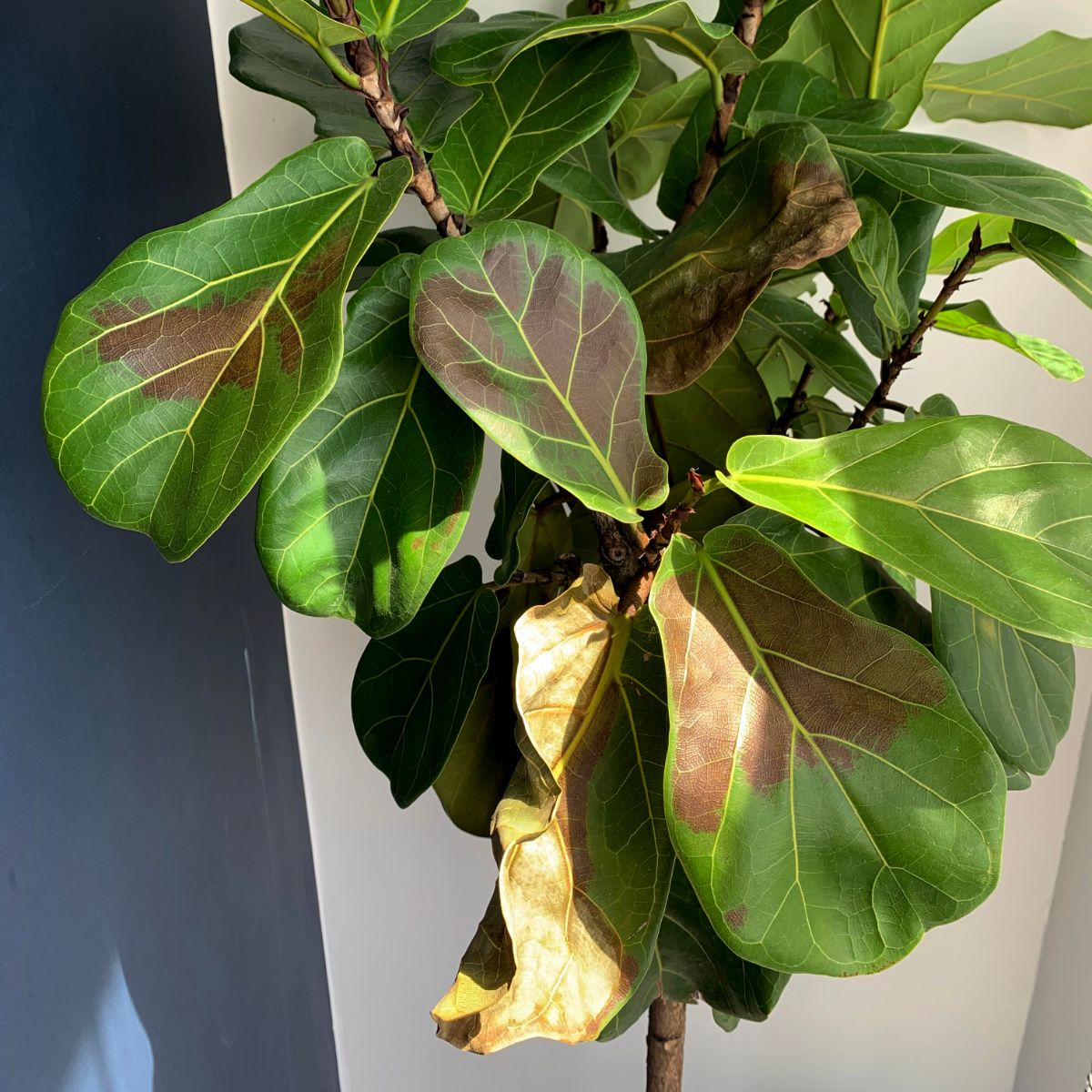
Fiddle leaf figs like a lot of bright suns, but too much direct light may cause leaf scorching and brown spots. Luckily, while sun-damaged leaves are unattractive, they are very easy to fix.
If you think sun damage may be the cause of your fig’s brown spots, signs to look for include the following:
- Assess your plant’s lighting situation. Is your plant in a very brightly lit spot? Alternatively, have you recently moved your plant into a brighter light?
- Brown spots from sun damage usually appear much lighter in color than damage from root rot or other issues. Plant leaves may appear bleached or tan in color, and they may look crispy too. Sun-damaged leaves may also turn yellow or red.
- Sun damage most often occurs towards the top of the plant and on the most exposed leaves. It is unlikely to be the cause of your plant’s distress if your plant has brown spotting on lower leaves.
What to do about it:
Sun-damaged leaves won’t recover, but you can easily prevent more brown spots from occurring by following a few quick steps.
- Adjust your lighting.
If you suspect your plant is suffering from sun damage, move your plant to a lower-light area. Plants in brightly lit windows can be protected from too much light by the addition of a sheer curtain or by moving them just a bit further away from the window.
- Acclimate your fig tree.
To prevent sun damage in the future, be sure to acclimate your fiddle leaf fig when moving it to an area with more light. To do this, slowly increase the amount of light your plant is exposed to over the course of a week or two. When properly acclimated, fiddle leaf figs usually do well in bright to bright, indirect light.
3. Underwatering
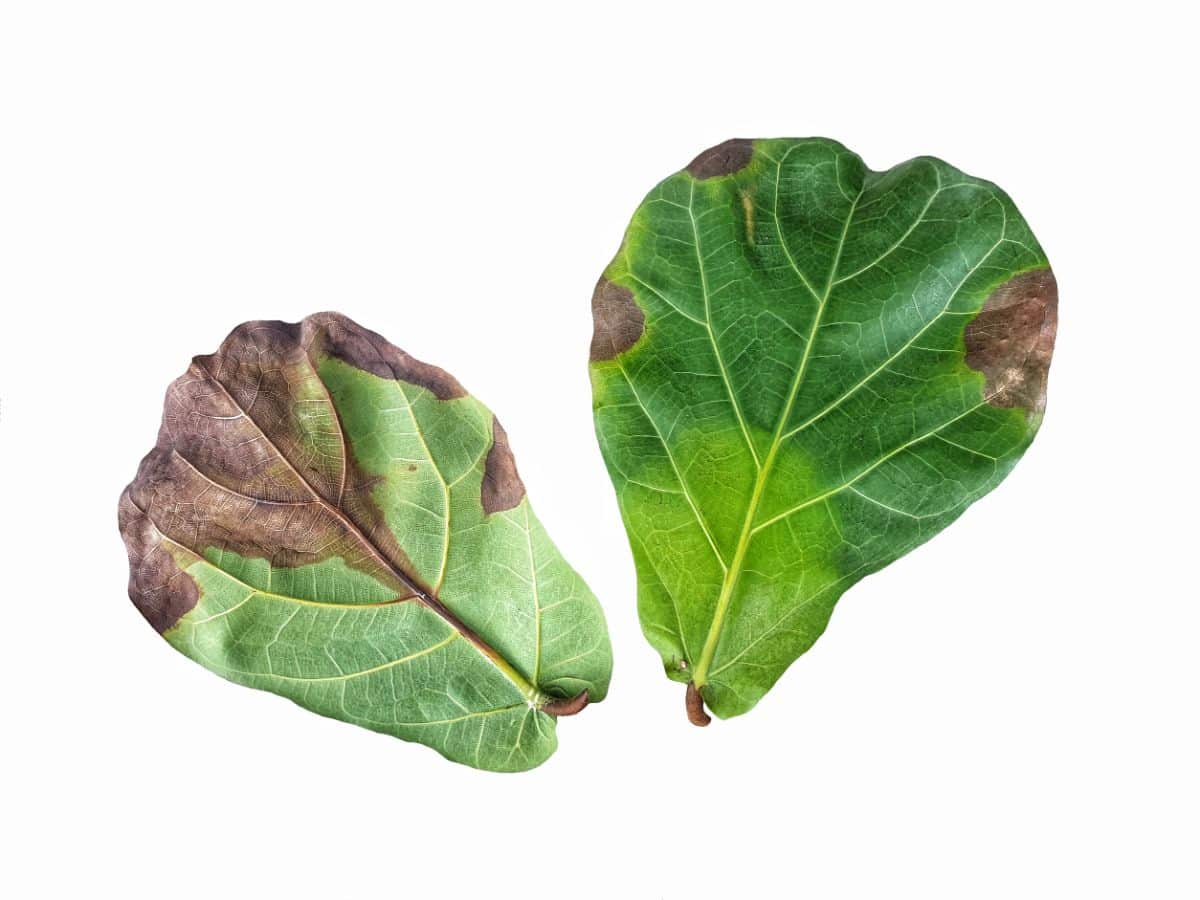
Like other tropical plants, fiddle leaf figs need regular watering and adequate humidity levels (between 30 and 65%). Allowing your plant to dry out too much may also cause it to develop brown spots on its leaves. If you think your fig may be underwatered, signs to look for include the following:
- Very dry soil. Insert your finger into your fiddle leaf fig’s pot and check your moisture levels. Your fiddle leaf fig should be allowed to dry out somewhat between waterings, but parched soil is a clear sign it’s time to water.
- Dry and crispy leaves. Brown spots from underwatering are usually lighter in color than spots caused by issues like root rot or bacterial infections.
- Damage from underwatering usually starts at the edges of leaf tips and works its way toward the center of leaves as damage progresses.
- Leaves may look wilted and droopy.
What to do about it:
Although underwatering can cause leaf damage, these issues are easier to fix than issues caused by overwatering and are less likely to create lasting damage.
- Adjust your watering schedule.
Fiddle leaf figs should generally be watered once every 1 to 2 weeks or when the top 1 to 2” of soil feels dry to the touch. Figs will need more water during the growing season and less water during the winter. Checking your soil with a moisture meter can also help you better determine when your plant needs water.
- Increase humidity.
Fiddle leaf figs can generally handle average household humidity levels, but if your home is very dry, particularly in winter, you may want to give your fig a humidity boost. Placing your fiddle leaf fig near a humidifier or moving a pebble tray under your plant can make sure humidity levels are optimal.
- Move your plant.
Fiddle leaf figs can be finicky plants and don’t like temperature extremes. If your fig tree is located near an A/C or heating unit, you may want to relocate your plant to a different spot.
4. Insect damage
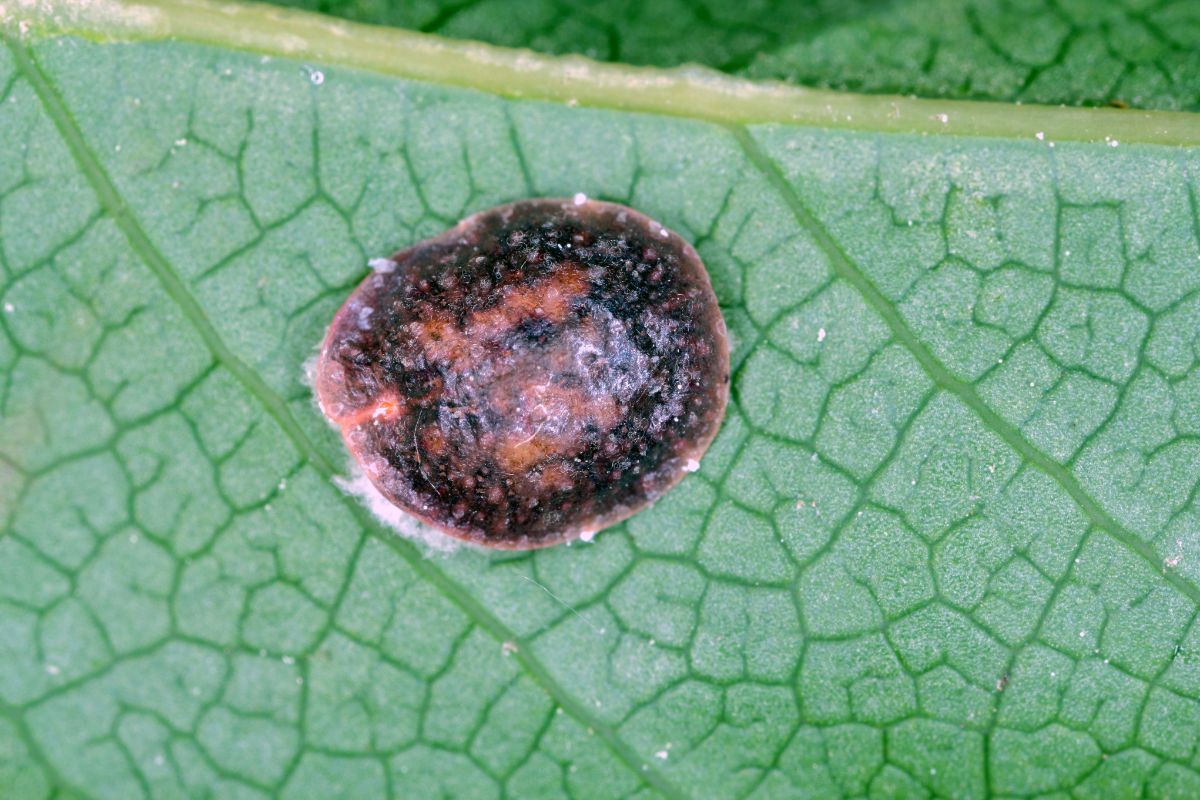
Like other houseplants, fiddle leaf figs can be susceptible to plant pests, like aphids, thrips, scale, and spider mites. These pests feed on the plant’s sap and can cause brown spots and other issues. If left untreated indoor pests can even weaken or kill your fiddle leaf fig, so if you suspect pests are the cause of your fig’s brown spots, you’ll want to act fast.
To determine if your fiddle leaf fig has pests, check your plant over carefully, looking at both the tops and bottoms of your plant’s leaves. You’ll also want to check along the plant’s stems and the soil around your plant too. Different pests may leave different traces behind, but some of the top signs to look for include the following:
- Scale insects can look like small, brown bumps or warts on leaf surfaces and plant stems, while spider mites can resemble small, white dots scurrying around on your leaves.
- Brown, sunken spots at the centers of leaves. Spots may also develop into holes.
- Small spots on leaf surfaces that may be yellow, brown, or black. Leaves may also exhibit a characteristic stippling pattern, which is produced when sap-sucking insects feed.
- Webbing on leaf surfaces can look a lot like spider webs; however, upon closer inspection, you may see small spider mites, not spiders.
- Sticky residue on leaf surfaces. This is called honeydew and is excreted by some insects when feeding.
- Warped or distorted leaves that can look crumpled.
- Insects will often target new growth first and then spread to older leaves.
What to do about it:
Once you’ve determined that pests are plaguing your fiddle leaf fig, there are several effective, organic control methods you can use.
- Insecticidal soap
Organic, insecticidal soaps can be purchased online, or you can make your own by simply mixing a few drops of Castile or Dawn dish soap into a quart of water. To apply, spray your plant liberally on both the tops and bottoms of plant leaves, along plant stems, and at the soil line too. Reapply treatment every 7 to 10 days until all signs of pests are gone, and then spray your plant one more time, just to be safe.
- Neem oil spray.
Neem oil is another useful, organic pest control method that is used just like insecticidal soaps. Just be sure not to apply neem when the sun is shining, as this can cause leaf burn.
- Horticultural oils.
Hard bodied scales can be quite tricky to eradicate, but horticultural oils usually will do the trick.
5. Bacterial infection
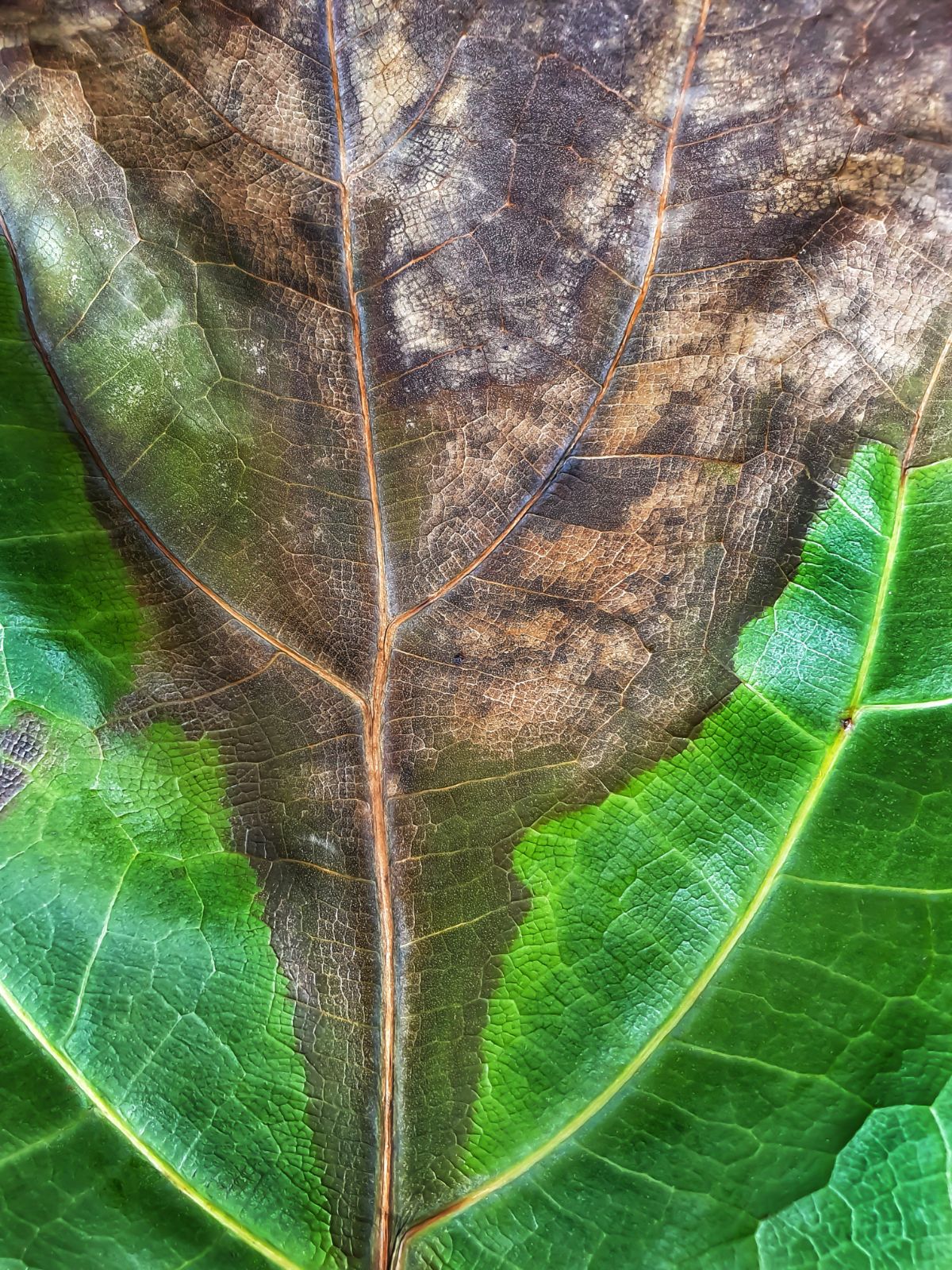
Brown leaves in fiddle leaf figs can also be caused by a bacterial infection. Unfortunately, bacterial infections can be very difficult to differentiate from root rot, and they are often more difficult to treat. Signs to look for include:
- Fiddle leaf figs experiencing a bacterial infection will develop brown spotting on their leaf surfaces; however, these brown spots are usually a bit lighter in color than brown spotting from root rot. Colors will commonly range from tan to dark brown.
- Unlike root rot, brown spotting caused by bacterial infections usually occurs across the leaf surface, not just at the leaf margins.
- Brown spots will occur at both the top and bottom of the plant at the same time.
- Leaf drop will occur, as with root rot; however, leaves will drop from the top of the plant, as well as the bottom.
What to do about it:
Unfortunately, bacterial infections in fiddle leaf figs are some of the trickiest issues to treat, but it may still be worth a try.
- Reduce watering and increase lighting.
Treatment for bacterial infections is very similar to how you would deal with root rot. Most importantly, you’ll want to reduce watering and only water your fig tree as needed when the top 1 to 2” of soil is dry to the touch. You’ll also want to make sure that your plant is potted up in a well-draining pot and that it’s receiving enough light.
- Repot your plant.
Swapping out your plant’s soil with a fresh potting mix can also help your plant cope with bacterial infections. Make sure whatever soil you use is rich and well-draining and that your fig is potted up in a planter with adequate drainage holes. You can also use this time to snip away any damaged leaves with pruning shears.
- Move your plant outside.
Weather permitting, moving your plant outdoors into an area of partial shade can help your fiddle leaf fig recover more easily from bacterial infections. With more airflow and sunlight, your plant has better chances of bouncing back. Just make sure temperatures are above 50°F and below 95°F to avoid stressing out your fig, and don’t place your fig in very bright sun.
If less than 50% of your plant’s leaves are damaged, you may have success with treatment; however, if most of your plant is damaged, it may be easier to toss your plant and buy another one. You may want to call up your plant nursery and ask for a replacement fiddle leaf fig if you recently purchased your plant. Some nurseries will be happy to help.
Frequently asked questions
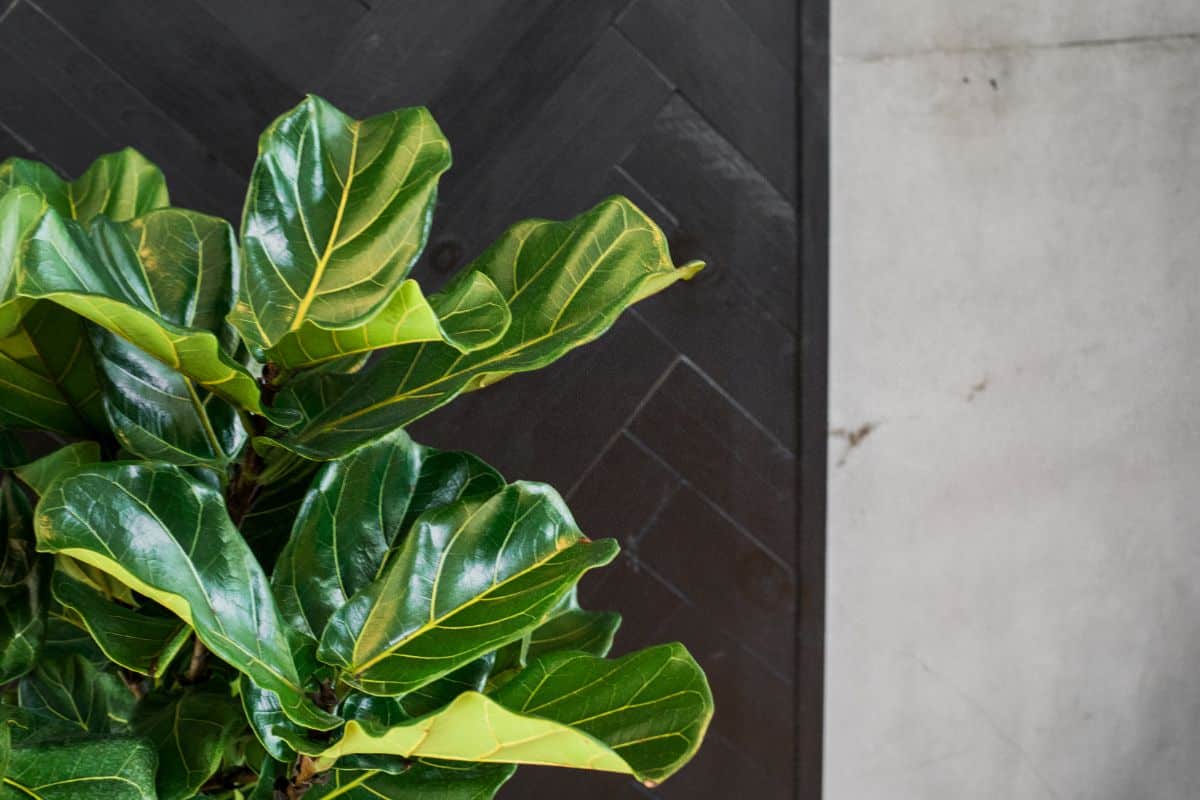
Once fiddle leaf fig leaves are damaged with brown spots or other issues, that damage is irreversible. However, if you can determine what is troubling your plant, you can prevent further issues from occurring. Common causes of brown spots on fiddle leaf fig trees include root rot, bacterial infection, and sun damage.
Bacterial infections can be one of the trickiest issues to manage in fiddle leaf fig trees. Signs that a fiddle leaf fig may be suffering from this issue include leaves that develop brown spots across the entire leaf surface. Leaves on the top and bottom of the plant will be impacted, and your tree may drop leaves too.
Fixing brown spots on fiddle leaf figs starts with identifying what is causing the spots to begin with. Treating spots caused by root rot and bacterial infections may require you to adjust your watering regime and lighting. While damage from insects or the sun will need other treatment.
Yes. If less than 50% of your plant’s leaves are damaged, pruning away brown leaves can help your plant redirect its energy toward recovery and new growth. It will also make your fig tree look much better!
Yes. Fiddle leaf figs can be targeted by a number of common houseplant pests, including spider mites, thrips, scales, and aphids. These pests can cause a lot of damage to your fig tree, including brown spotting on leaf surfaces.
Brown spots on fiddle leaf fig leaves are one of the most common signs that your plant could use some extra TLC. Other signs that fiddle leaf figs may be in distress include yellowing or otherwise discolored leaves, leaf drop, drooping leaves, or poorly formed leaves.
Summary
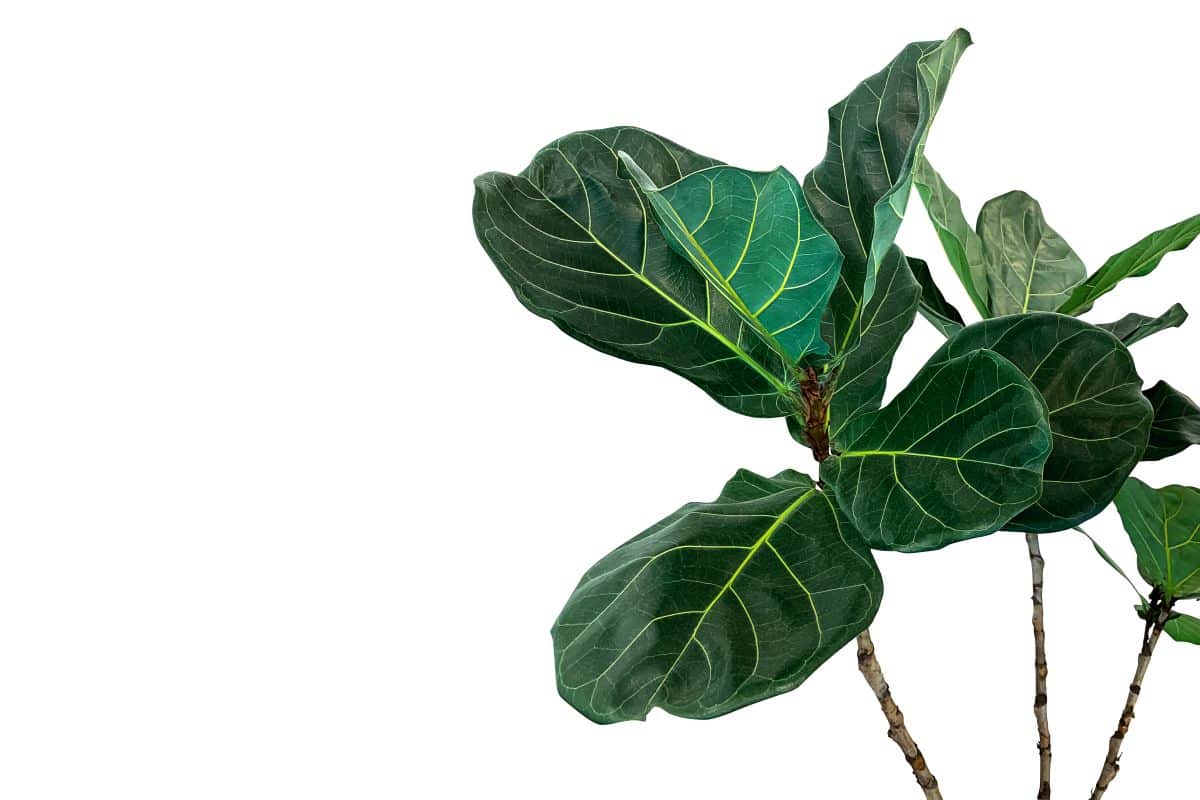
Brown spots on fiddle leaf fig tree leaves can certainly be troubling, but they are usually treatable; however, the first step towards treatment is to identify the cause of your plant’s distress.
From overwatering to pests, there are several common causes of brown spots on fiddle leaf figs. Once you know what signs to look for, treatment can be as simple as adjusting your plant’s watering regime or lighting. Once you’ve addressed the root cause of brown spotted leaves, your fig tree can bounce back in just a few weeks and start producing more of those gorgeous, green, fiddle-shaped leaves we all have come to love!
If you liked this article and would like to learn more about indoor plant care, check out our other guides here.

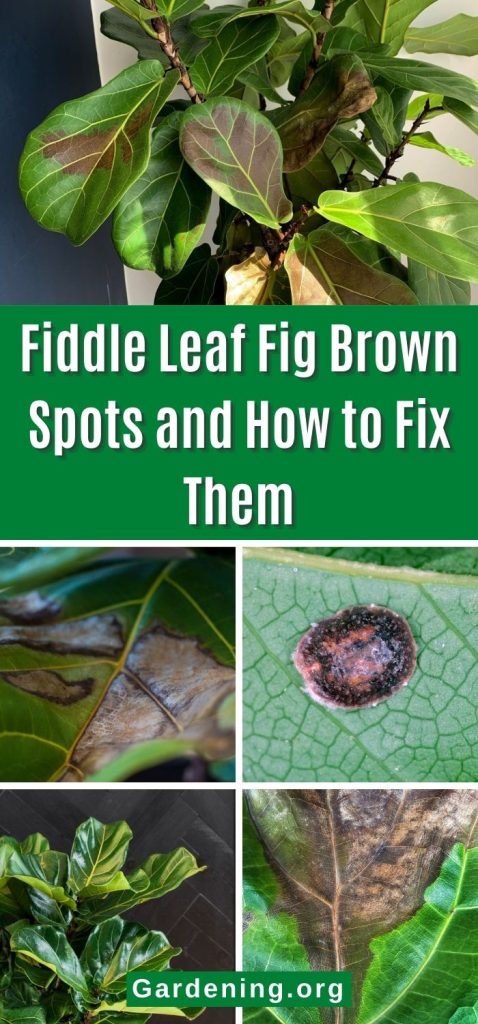
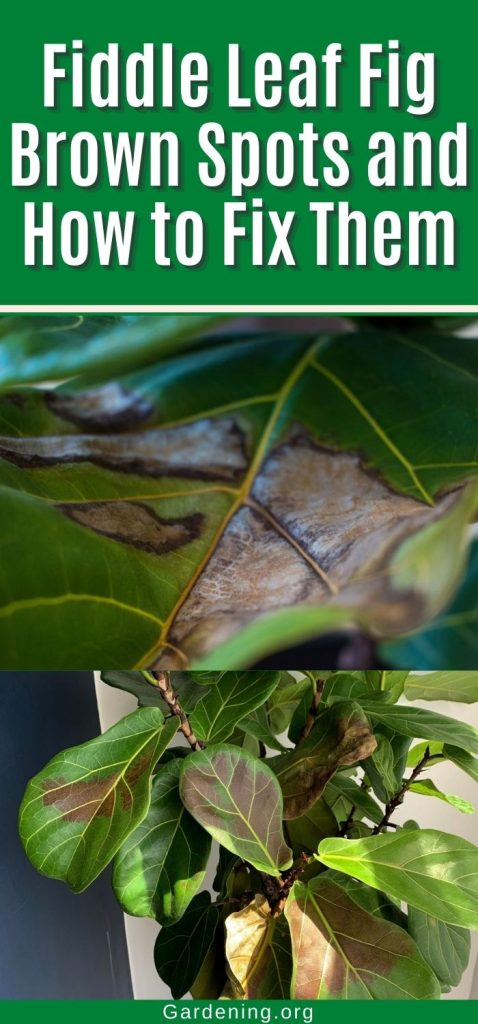
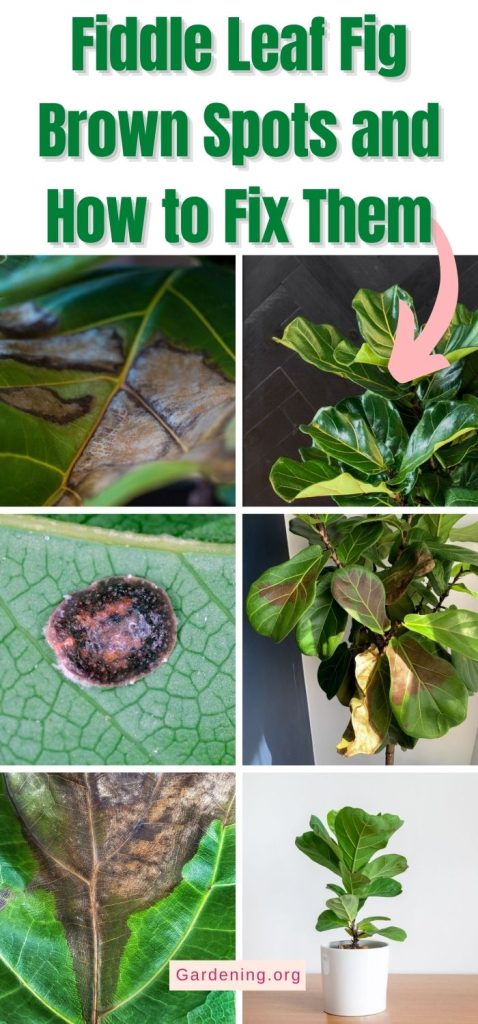
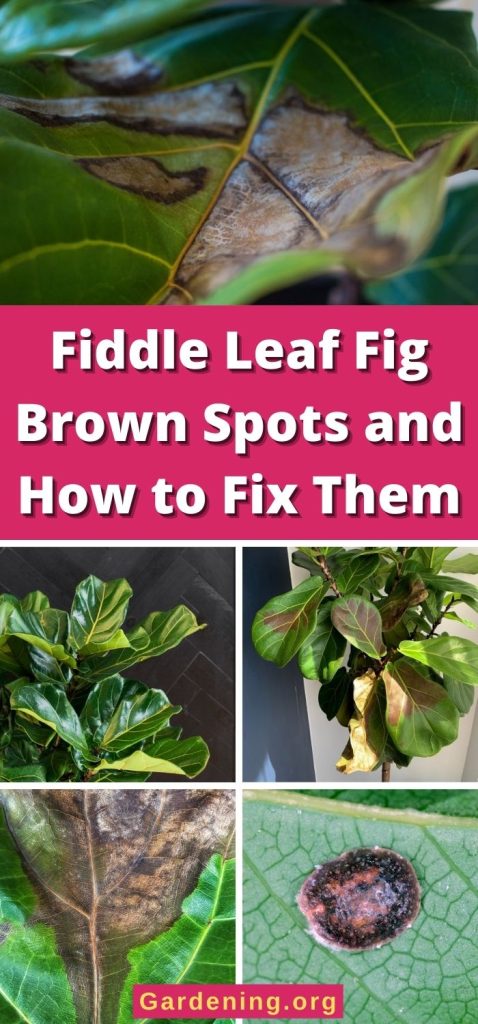
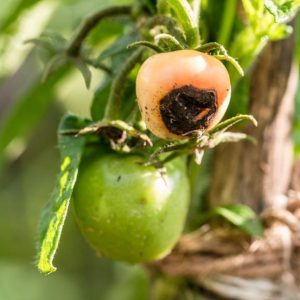
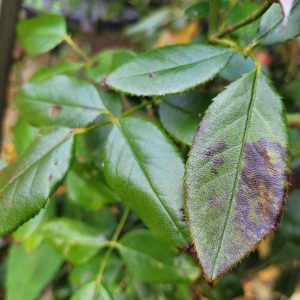
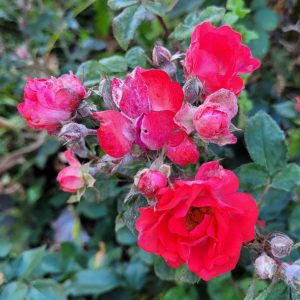
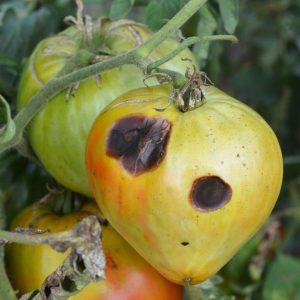
Leave a Reply